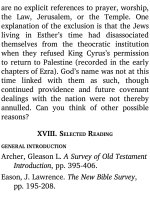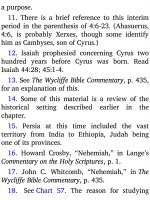Jensens survey of the old testament adam 181
Bạn đang xem bản rút gọn của tài liệu. Xem và tải ngay bản đầy đủ của tài liệu tại đây (118.38 KB, 4 trang )
Bathsheba (2 Sam 12:24).
2. A Shulamite woman. The name
“Shulamite” appears only at 6:13 (KJV). It is
probably derived from the place called
Shunem, located a short distance north of
Jezreel near the plain of Megiddo (cf. Josh
19:18; 1 Sam 28:4; 1 Kings 1:3; 2 Kings 4:8).
See Map R.
3. Daughters of Jerusalem. The identity of
these women is not disclosed. They may
have been companions of the bride,
attendants of the king’s palace, or interested
onlookers. Some commentators assign a few
verses of the text to other speakers (e.g., an
officer of the king’s guard, 3:7-10).
H. A. Ironside’s description of the setting
of this story, as summarized by Merrill
Unger, is quoted here at length:
King Solomon had a vineyard in the
hill country of Ephraim, about 50 miles
N of Jerusalem, 8:11. He let it out to
keepers, 8:11, consisting of a mother,
two sons, 1:6, and two daughters—the
Shulamite, 6:13, and a little sister, 8:8.
The Shulamite was “the Cinderella” of
the family, 1:5, naturally beautiful but
unnoticed. Her brothers were likely
half brothers, 1:6. They made her work
very hard tending the vineyards, so
that she had little opportunity to care
for her personal appearance, 1:6. She
pruned the vines and set traps for the
little foxes, 2:15. She also kept the
ocks, 1:8. Being out in the open so
much, she became sunburned, 1:5.
One day a handsome stranger came
to the vineyard. It was Solomon
disguised. He showed an interest in
her, and she became embarrassed
concerning her personal appearance,
1:6. She took him for a shepherd and
asked about his
ocks, 1:7. He
answered evasively, 1:8, but also spoke
loving words to her, 1:8-10, and
promised rich gifts for the future, 1:11.
He won her heart and left with the
promise that some day he would
return. She dreamed of him at night
and sometimes thought he was near,
3:1. Finally he did return in all his
kingly splendor to make her his bride,
3:6-7.3
The above description will help you catch
something of the tone of the book as you
begin your survey study.
G. SCHOOLS OF INTERPRETATION
The Song of Solomon has been interpreted
in three different ways:
1. Naturalistic. It is a human love story, of
literary merit, with no typical or gurative
meaning intended.
2. Allegorical. It is purely gurative, not
based on historical fact.
3. Typical. It is teaching by (1) example,
from historical facts; and
(2) type, from viewing these historical facts
as gurative representations. In the words of
Scroggie, “As in Jonah, we have allegory
emerging from history.”4 G. Campbell
Morgan describes this methodology of
interpretation.
The songs should be treated then, rst
as simple and yet sublime songs of
human a ection. When they are thus
understood, reverently the thoughts
may be lifted into the higher value of
setting forth the joys of the
communion between the spirit of man
and the Spirit of God, and ultimately
between the Church and Christ.5
This survey guide follows the typical view.
H. TYPICAL TEACHING









